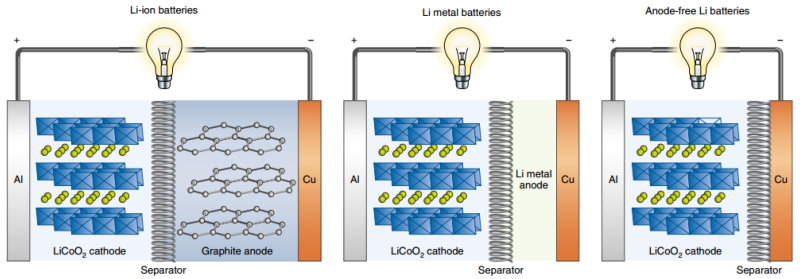
Can the Li-ion battery ditch the anode altogether?
Conventional lithium-ion batteries shuttle lithium ions back and forth between two electrodes – the anode and the cathode. The cathode is often an oxide, which reversibly reacts with the lithium ions. For example, during discharging, cobalt oxide (CoO2) ‘absorbs’ lithium ions and electrons to form lithium cobalt oxide (LiCoO2). During charging, the reverse happens and lithium atoms travel to the anode, finding refuge in the layered carbon structure of graphite – the most-used anode material.
A lot of the improvement in battery capacity and performance over the past decades has been realized by tweaking the chemistry and engineering. Adding a pinch of this or that, making the foils on which the electrodes reside a little thinner – that sort of thing. This has been a delicate balancing act, as changes to improve one aspect usually negatively affect another. Boosting energy density, for example, might reduce lifetime.
All in all, carefully turning the knobs has paid off. You might be disappointed that your phone battery still only lasts a day, but batteries have objectively gotten better. What can be done to improve them even more?
Alive
A lot of eyes have been on the anode. The amount of lithium that graphite can store in today’s batteries is very close to the theoretical maximum. The search for an alternative anode material turned up silicon, which theoretically can accommodate up to ten times more lithium than graphite. Plain silicon, however, is unsuitable because it has the propensity to crack under the constant stress of having to load and unload guests. Dutch startups Leydenjar and E-magy, among others, have developed nanotextured silicon that mitigates this issue. Leydenjar claims its silicon-anode batteries pack up to 70 percent more energy than the graphite-anode equivalent.
But why use a host material at all? Nothing packs more lithium than lithium itself. Indeed, in the early days of lithium-ion batteries, solid lithium metal was used as the anode, but this produced serious stability problems. Today, the dream is still very much alive, though: researchers and companies alike are working on rechargeable Li-metal anode batteries (disposable ones are available).
Breakthrough
Conceptually, the next step would be to ditch the anode altogether. Instead, there’s just a current collector, upon which lithium is electrodeposited during charging – a process called plating.

This, too, is being worked on. The difference between a Li-metal anode battery and an anode-free one is subtle. In the former, there’s always a bit of solid lithium present, regardless of the charge state. In the anode-free version, there’s no solid lithium where the anode would be in the fully discharged state.
Minimizing the amount of material at the anode side reduces the weight and the thickness of the battery, increasing the amount of energy per unit mass and volume (although the volume change as a result of plating needs to be accommodated). Furthermore, the cost, energy and technological requirements associated with anode production are saved.
The approach isn’t without its challenges, of course. Lithium deposition tends to be messy. It’s a very reactive metal, causing decomposition of the electrolyte, ie the medium that takes lithium back and forth inside the battery. This results in spiky structures called dendrites, which can short-circuit the battery. Formation of ‘dead’ lithium is a major challenge, too: some lithium, once deposited, refuses to turn back into ions again.
Progress is being made to deposit lithium more uniformly and to inhibit dendrite growth and dead lithium formation, but the anode-free battery still requires a breakthrough or two before it can even be considered for commercial application. And, of course, it remains to be seen how it will stack up against more traditional designs such as the silicon-anode battery.





